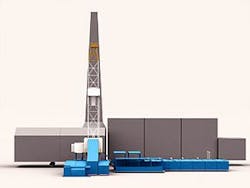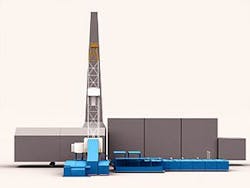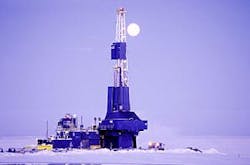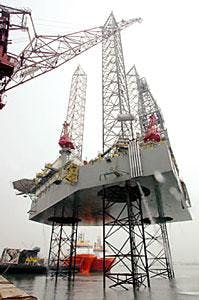The drilling market is increasingly robust with an ever-increasing demand for rigs from a fleet of relatively fixed-size. Utilization is high, with some room for improvement among certain rig types and in some markets. Operators will need to be flexible and creative in order to accomplish their drilling goals under deadlines imposed by lease agreements.
North American market
US oil and gas drilling activities are at a 19-year high. In April 2005, 1,325 rigs were operating compared with 1,161 in April 2004. In spite of skyrocketing profits, according to Economic & Technical Consultants Inc., the growth in capital spending in 2005 will be slower than in 2004.1
North American land-rig drilling is up 13% from a year ago, according to Baker Hughes Inc.’s North American rotary rig counts for Apr. 29, 2005.
Richard J. Mason, in the Mar. 31 issue of The Land Rig Newsletter, described the US land drilling market as “moving from tight into a stressed mode.” He says that finding drilling rigs has become a challenge for operators, as activity has reached the upper limits of fleet capacity.
Although more than 100 rigs came into the fleet in both 2003 and 2004, Mason envisions only several dozen more being added in 2005. About two-thirds of the land rigs added to the market will be reactivated cold-stacked rigs, he says.
Market leaders Grey Wolf Inc., Nabors Drilling US LP, and Patterson-UTI Energy Inc. collectively control about 300 cold-stacked rigs, but there is a backlog on parts, components, and yards, and a lack of experienced personnel to rebuild and operate the extra units. Grey Wolf is rebuilding six rigs, Nabors expects to have 20 additional rigs available and working by the end of the year, and Patterson-UTI is reactivating five rigs/quarter.
US offshore drilling is down about 8%, Gulf of Mexico drilling is down 10% from a year ago, but the overall North American rig count is still up 13% from late April 2004.
Texas (601 rigs), Louisiana (178), and Oklahoma (158) led the US in rotary rig operations for the week of Apr. 29, accounting for 78% of all working US land rigs.
The Weatherford Intl. Inc. and Assoc. of Energy Service Co.’s US well service rig count increased to 2,931 active rigs in March 2005, up 81 rigs from a year earlier. Service rig fleet utilization in the US was at 69%.
According to a Drilling Records’s report (drillingrecords.com) from Apr. 29, 2005, there were 180 rigs drilling in Western Canada, including 136 in Alberta, 34 in British Columbia, and 15 in Saskatchewan. This represented 25% utilization of all available rigs (728).
Alaska
Baker Hughes reported 8 land rigs drilling in Alaska the week of Apr. 29, 2005, down 4 from mid-April.
The new Doyon Akita JV was announced last month, along with plans for a new mobile arctic rig to drill on the North Slope for Pioneer Natural Resources Co.
Karl Rudd, COO of Akita Drilling Ltd. told OGJ that the new Arctic Fox land drilling rig will be built in Nisku, Alta., and transported to Alaska in late 2005. According to Susan Spratlin, vice-president of communications at Pioneer, the new rig will be similar to other light rigs being used in Canada, but much more portable than rigs now being used on the North Slope (Fig. 1).
The in-line layout design includes a telescoping double mast (rated to 400,000 lb) for efficient rig moves and will require 35 winter loads including drill pipe and spares. The rig will be able to drill wells up to 10-12,000 ft, depending on the casing program.
The derrick will be capable of racking 10,000 ft of 41⁄2-in drill pipe or 11,800 ft of 4-in. drill pipe. The substructure is designed to handle 11-in. or 135⁄8-in. 5,000 psi BOP stacks. Equipment includes three 800-hp triplex mud pumps and three 4-panel linear motion shale shakers.
Nabors Alaska Drilling Inc. currently operates a fleet of 14 specialized arctic drilling rigs and 3 workover rigs on the North Slope, in addition to 5 drilling rigs at Cook Inlet. The North Slope drilling fleet includes eight 2,000-2,100 hp rigs, four 1,000-hp rigs, and one 400-hp rig (Fig. 2). The workover rigs are 600-700 hp. Nabors’ Cook Inlet rigs are 850-3,000 hp.
Personnel shortage
In an annual study released Apr. 19, Houston-based energy research firm John S. Herold Inc. found that employment by the largest US oil and gas companies declined 4.1% in 2004.2 More than 21,000 jobs were cut at the top 25 companies in 2004, contributing to the nearly 120,000 jobs cut at those companies since 1974. Arthur L Smith, Herold chairman and CEO, said the “brain drain” in the energy industry preordains a severe personnel crunch and suggests that US industry might not have time to recover “from its mistakes of the past.”
Although advances in drilling and completion technology have somewhat reduced the rig staff requirements, upstream operations have expanded worldwide, adding pressure to the demand for drilling equipment and operators.
Globalization is the most significant trend of these times, says foreign affairs expert Thomas L. Friedman in his recently published book, The World is Flat. The integration of China and India into the global supply chain for manufacturing and services has created an explosion of wealth in those countries with a concomitant spike in demand for energy. Increased demand and increasing prices have driven drilling markets to new heights in the past year, but the infrastructure is slow to develop due to constraints on materials and long lead times for construction.
We have seen increasing capital investment in the fleets, but little investment in personnel capital. Royal Dutch/Shell Group’s recently announced plan to hire more than 1,000 petroleum professionals begs the question of where such staff can be found.
Rig fleet utilization
The Baker Hughes worldwide rig count for March 2005 is down 5% from February, but up 9% from a year earlier. The count in Europe was up 17 rigs and the Middle East was up 14 rigs from February, but the rig counts were lower in Africa (-2), Latin America (-3), and Asia Pacific (-11).
According to the ODS-Petrodata Group, the utilization of mobile offshore drilling rigs worldwide for the week ending Apr. 29, 2005, was 88%, about the same as the previous week and month but up from 82% a year earlier (based on a fleet of 642).
Utilization of the Gulf of Mexico jack up fleet (155 units) was 86%, up from 71% a year earlier, and up from nearly 79% 5 years earlier.
In Europe and the Mediterranean, the mobile offshore fleet (99 rigs) utilization was up to 94% from 82% a year earlier.
In addition to the mobile drilling units, ODS-Petrodata counts 294 offshore platform rigs deployed worldwide. As of Mar. 2, 226 rigs were contracted worldwide, representing 77% utilization. 107 of 109 rigs in Europe and the Mediterranean were under contract, for 98% utilization, and 26 of the 65 platforms rigs in the US Gulf of Mexico, with a low utilization of only 40%.
Day rates, SCORE
Offshore rig rates are increasing all over the world, according to the ODS-Petrodata day rate indices issued Apr. 8. The US Gulf of Mexico jack up day rate index was at 232 for April 2005, its highest since September 2000 (based on the average market day rate in January 1994 = 100). ODS analysts expect that the strong demand for rigs will put upward pressure on day rates for the rest of the year.
The ODS-Petrodata North Sea jack up day rate index was at 270 for April; the highest since early 2002 and expected to rise further. The deepwater rig day rate index, which had been increasing slightly over the last few months, was at 345 for April. The midwater depth semisubmersible day rate index has been fluctuating over the last few months but rose to 317 in April. Analysts expect a continued upward trend.
Typical day rates in April 2005 for different offshore rig categories, according to Rigzone, appear in Table 1.
GlobalSantaFe Corp.’s monthly summary of current offshore rig economics shows that offshore day rates continue to increase worldwide. The overall worldwide SCORE in March 2005 was 63.8, up 4.9% from the previous month, up 44% from the previous year, and up 136% compared with 5 years ago.
The SCORE for jack ups worldwide was 62.7 in March 2005, up 2% from the previous month, up 16% from a year ago, and up 109% over the past 5 years. The SCORE for semisubmersibles worldwide was 65.3 in March, up nearly 9% from February, up nearly 89% from a year ago, and up 175% from 5 years ago.
The Gulf of Mexico rig market showed the largest monthly and annual changes, up 5.5% from February and up 71% from March 2004. The North Sea rig market showed the largest 5-year change, up 240% from March 2000, as well as the second largest monthly (up 2.6%) and annual (up 67%) changes.
SCORE compares the profitability of current mobile offshore drilling rig day rates to the profitability of day rates at the 1980-81 peak of the offshore drilling cycle. At that time, SCORE averaged 100%, and new contract day rates equaled the sum of daily cash operating costs plus about $70/day/$1million invested.
New sixth-generation semisub
On Apr. 15, Norway’s Smedvig ASA announced an agreement with Eastern Drilling ASA to supervise construction, market, and operate a new sixth-generation semisubmersible drilling rig for 10 years following delivery. Smedvig will hold 10% ownership in the rig. Smedvig CEO Kjell E. Jacobsen said that the company’s participation “demonstrates our long-term confidence in the drilling markets.”
The rig will be built by Samsung Heavy Industries Co. Ltd. in South Korea and delivered in fourth-quarter 2007. It will begin operations in 2008. The $550-million construction contract between Eastern Drilling and Samsung includes an option for a second unit, which must be exercised within 12 months.
The rig will have dynamic-positioning capability and will feature a dual derrick, 6,000-tonne variable deck load capacity and a water depth capability of 9,843 ft. It will be designed for work in extreme northern climates and will be outfitted with a zero-discharge, closed drainage system.
New jack ups on order
Norway’s Petrojack ASA has contracted with Singapore’s Jurong Shipyard Pte. Ltd., a subsidiary of SembCorp Marine to build a second Baker Marine Pacific Class 375 jack up. Baker Marine Pte Ltd. is a subsidiary of PPL Shipyard Pte. Ltd. and SembCorp Marine.
The rigs will be capable of drilling to 30,000 ft in water depths to 375 ft and are designed with a 21.3 m-cantilever extension to handle a maximum combined variable load of 3,401 tonnes.
Petrojack announced a letter of intent for the $127.1-million contract with 80% financing on Apr. 15. The Petrojack II will be identical to the Petrojack I jack up currently under construction at Jurong Shipyard, and Jurong has an option to build one additional unit. Petrojack I is scheduled for delivery in second-quarter 2007 and Petrojack announced that earlier contract for $131 million. The Petrojack II will be delivered in mid-January 2008.
ENSCO International Inc. has placed an order for another KFELS B Class jack up with Keppel FELS Ltd. in Singapore, a subsidiary of Keppel Offshore & Marine Ltd. The $117.2-million contract to build the ENSCO 108 was announced on Apr. 5. The new rig will replace the ENSCO 64, damaged by Hurricane Ivan in September 2004 (OGJ, Nov. 15, 2004, p. 45).
This will be the seventh independent leg cantilever jack up built for ENSCO at KFELS since 1999. The ENSCO 101 and 102 are Mod V Class units delivered in 2000 and 2002 respectively. The ENSCO 104 and 105 are Mod V-B (Super B) Class jack ups delivered in 2002 and built at KFELS and AMFELS yards, respectively. These rigs are capable of working in 375-ft water depth and drilling to 30,000 ft. The ENSCO 106 and 107, sisters to the ENSCO 108, are Mod V-B Class design, capable of working in 400-ft water depth.
References
1. Daily FERC, Apr. 18, 2005, www.dailyferc.com.
2. Smith, A.L, and Fan, A., Energy Headcount Slumps Despite Record Oil prices and Bright Fundamental Outlook, John S. Herold Inc., Apr. 15, 2005.




